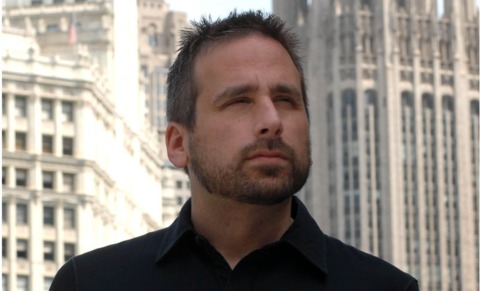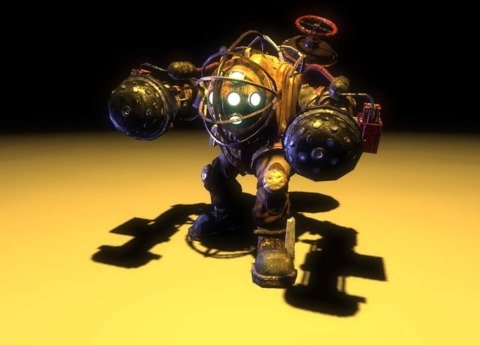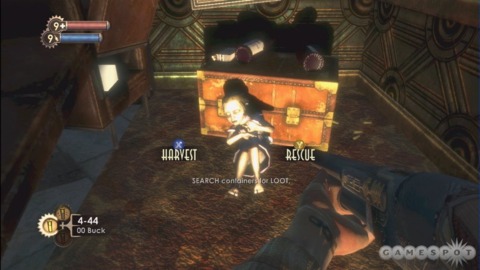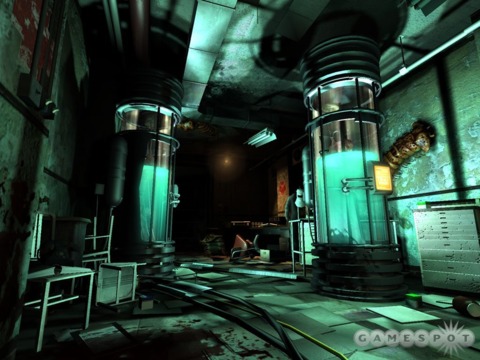GDC '08: Ken Levine on BioShock's 'stupid story'
2K Boston creative director explains how his team got gamers to care about why they were shooting stuff in last year's hit undersea action game.
When 2K Games' BioShock arrived on the scene last year, it did so amid an outpouring of critical acclaim. Reviewers and consumers alike lauded the atmosphere of the game's underwater utopia-gone-wrong, the open-ended approach to combat, and perhaps most of all, the game's twisting, ethically ambiguous story.

That story was the topic of discussion during a Game Developers Conference session delivered by 2K Boston president and creative director Ken Levine this morning. An enthusiastic crowd greeted Levine, who spent the moments before his presentation posing for photos with fans, engaged in friendly chatting, and signing autographs. But once the presentation began in earnest, it was time for a little tough love.
"The bad news for storytellers is that nobody cares about your stupid story," Levine said. "Nobody cares about the thing you've been writing in your math notebook since you were in 11th grade about the dark lord Lagon and the fifth period of the Elven uprising, and all that crap you've been working on forever. I know that's hard to hear because you care about it a lot, but the audience is not your mom; they have no reason to be predisposed positively to the things you've been thinking about, no matter how detailed or lovingly you crafted it."
Details, Levine said, are not the gaming storyteller's friend. That would be the game's world, the thing with which players are constantly engaged, the thing they stare at constantly when they're not being yanked away for a cutscene or a menu. To give an example of how much the gameworld can say, Levine showed off an early prototype of BioShock. While some of the textures, water leaks, and the iconic Big Daddy certainly looked familiar, the dank corridors of the prototype seemed lifeless compared to the vision of Rapture portrayed in the final game.

Levine said the team scrapped the prototype and started over from scratch, a painful process he said is common in games. Where sculptors take a huge block of stone and chip away from it to make art, Levine said game developers have to first make the huge block of stone, which makes it much harder for the creators to then chip away at their own hard work to find the art underneath.
It wasn't just the environments of Rapture that had to be gutted and rebuilt. Levine said the original BioShock story was a confusing mess that spanned more than 70 years and featured dozens of characters. In 2006, the development team realized the story had gotten out of hand, so they just killed most of the characters, or combined them with others. Levine said by the end of the process, each character represented a single story thread or theme, a unique idea that no other character embodied.
It wasn't enough to have a pared-down story; it still had to be told well. Levine said the story had to work for three different levels of players. It had to work for gamers who only cared about Madden NFL or Halo 3 and just wanted to shoot stuff. For gamers who get a little deeper into their games, Levine said there was a supporting cast of characters and interesting concerns that they can follow along with, such as Fontaine's uprising and Tenenbaum's experiments with the Little Sisters.

Then there are the hardcore fans.
"You know how there are kids who listen to music, like it, dance it and get into it, but then there's that weird kid in the back of the classroom who'll be writing all the Nirvana lyrics on his notebook," Levine asked. "That's the level of the people who get into the game that you have to support."
That's the crowd for whom the developers threw in a host of wrinkles, obscure clues, and little touches to help flesh out the story. The key, according to Levine, is that all the extra depth for the hardcore fan cannot be allowed to get in the way of the experience for the more casual player who just wants something along the lines of Madden or Halo.
Another focus for the BioShock team was to not try to do what they couldn't do, Levine said. He didn't want things that could break the game experience for the player or pull them out of the experience, like doors that never open or are just textures on a wall, or people who don't behave in a reasonable way. That's one reason Levine said that pretty much every person in Rapture is already dead, and on the occasions where you do come face-to-face with other people who aren't insane with rage, they are typically killed off before there's any real chance for unrealistic behavior.
"If you want people to follow along with your plot, it has to be really f****** stupid," Levine said, drawing laughs. "What's your goal in Act 1 of BioShock? Get to the sub and escape Rapture. Everybody can follow that. What's your goal in Act 2? Well, the sub blew up, so I guess I have to kill Ryan to get out. Well, you got screwed over by Fontaine. What's your goal in Act 3? Kill Fontaine."
As straightforward as that plot sounds, Levine said it forms the basis for a detective story. Since a mystery novel is essentially interactive in the way it invites the audience to figure out "whodunit," Levine said the genre was ideally suited for games. The current generation of gaming hardware also contributes to the realization of mystery games, as developers have the horsepower to populate the world with clues both helpful and misleading, important and irrelevant.

In order to create a proper sense of mystery, Levine said storytellers need to strike a balancing act between asking questions and providing answers. Questions are inherently more interesting than answers, he said, but a game needs to provide answers sparingly to prevent the audience from getting frustrated and giving up on it.
When handled properly, Levine said that mystery can propel the audience experience forward immensely. He points to the final levels of BioShock as an example, saying that he thought they were among the best in the game from a gameplay perspective, but coming off the big confrontation with Andrew Ryan, players didn't have as much to pull them forward in the game and wound up enjoying it less.
One of the most compelling mysteries in the game at the outset was that of the Little Sisters and the Big Daddies. While the monstrous diving suit adversaries were in the game from the beginning, Levine said the Little Sisters were actually created only after a lengthy creative process and multiple iterations.
The game's original "gatherers" were actually sluglike creatures. The Big Daddies still protected the slugs, but the creatures didn't emote, and needed changing. The second iteration of the Little Sisters was a squat humanoid with the mutated face of a splicer, a uniform like a gas station attendant's, and a hose with which to extract precious fluids from corpses.
As the developers tried to make the gathering creatures easier to relate to, one designer went to one extreme of the empathy scale and mocked up an emaciated dog with crippled hind legs in a wheeled harness. From there the developers struck on a pallid, childlike creature with a defeated, hopeless demeanor, and eventually settled on the Little Sisters as they exist in the final game.
Just as the Little Sisters changed over the course of development, Levine said it was important for storytellers to adapt their tale to fit the game is it shapes up. He said he didn't actually have the story for BioShock nailed down until about eight months before it shipped, something he admits was a source of great frustration to some of his colleagues. However, he emphasized that writers need to be open to letting their games dictate where the story should go, as it's the intersection of storytelling and gameplay where the gaming medium can flex its strengths.
Got a news tip or want to contact us directly? Email news@gamespot.com
Join the conversation